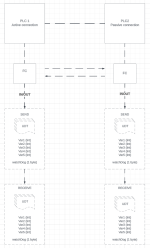LindeBerger
Member
Hi everyone
I've created an FC that includes the blocks TCON, TDISCON, TSEND and TRCV.
This block has to be as generic as possible across hardware so I can't use the TSEND_C and TRCV_C as these compact blocks aren't compatible with e.g. ET200S CPU. PUT/GET is out of the question because that's what I want to move away from.
I can make connection between two 1200 CPUs. I can also send/receive both ways without issues.
However, I need to create a "watch dog" that functions something like this:
PLC 1 sends the value of 1
PLC 2 adds 1 to the value of 2 and sends it back to PLC1
PLC 1 adds 1 to the value of 3 and sends it back to PLC2
if the value doesn't change then I have lost ccommunication between the two PLCs.
This task is very difficult to me because I'm not allowed to use any timers (IEC), CTUs, CTDs of any sorts with an instance.
I have to use an "Add" instruction and count up in a variable (1 byte) and perhaps use "Move" instructions.
I've uploaded a simple layout/topology of how it's structured and also a snippet of the logic for sending receiving watchdog values but I'm missing the last pieces.
I would really appreciate some sparring regarding this. I know what I want to do but I lack the skills to execute the plan.
I can upload the projectfile if nessecary.
Thank you in advance.


I've created an FC that includes the blocks TCON, TDISCON, TSEND and TRCV.
This block has to be as generic as possible across hardware so I can't use the TSEND_C and TRCV_C as these compact blocks aren't compatible with e.g. ET200S CPU. PUT/GET is out of the question because that's what I want to move away from.
I can make connection between two 1200 CPUs. I can also send/receive both ways without issues.
However, I need to create a "watch dog" that functions something like this:
PLC 1 sends the value of 1
PLC 2 adds 1 to the value of 2 and sends it back to PLC1
PLC 1 adds 1 to the value of 3 and sends it back to PLC2
if the value doesn't change then I have lost ccommunication between the two PLCs.
This task is very difficult to me because I'm not allowed to use any timers (IEC), CTUs, CTDs of any sorts with an instance.
I have to use an "Add" instruction and count up in a variable (1 byte) and perhaps use "Move" instructions.
I've uploaded a simple layout/topology of how it's structured and also a snippet of the logic for sending receiving watchdog values but I'm missing the last pieces.
I would really appreciate some sparring regarding this. I know what I want to do but I lack the skills to execute the plan.
I can upload the projectfile if nessecary.
Thank you in advance.







